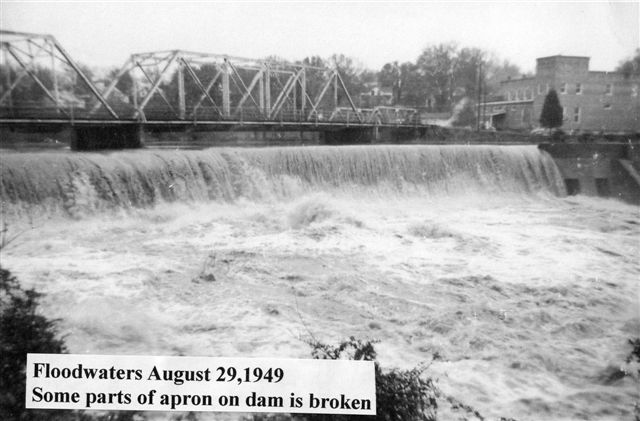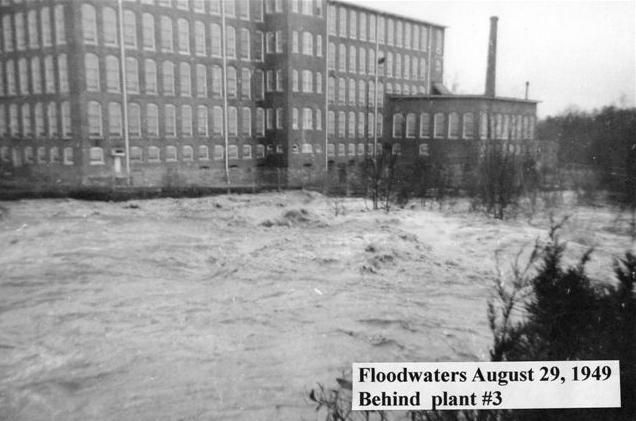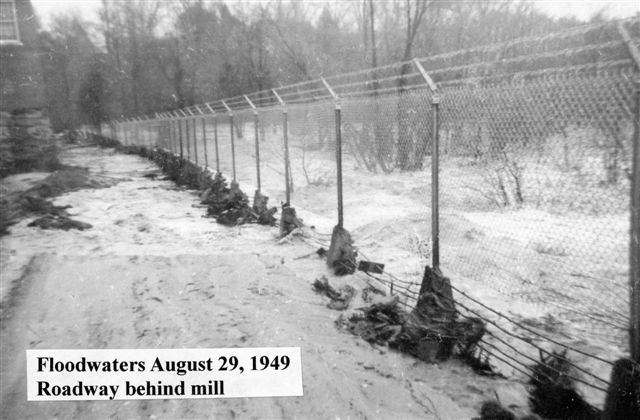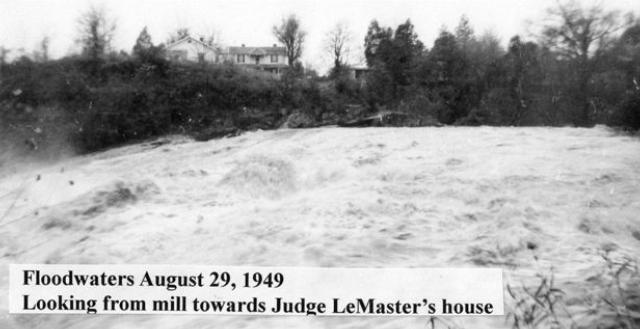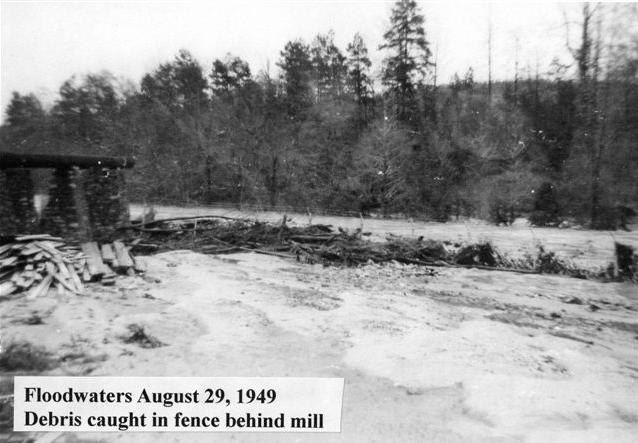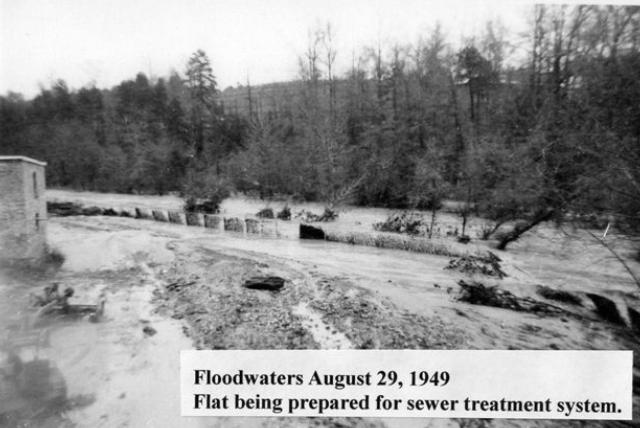The Flood Waters of Lawson's Fork Creek
Story furnished by Clarence Crocker
The little friendly stream known as Lawson’s Fork Creek gets it’s beginning from branches and smaller creeks in the foothills of South Carolina near the town of Campobello. Winding some 29 miles through Spartanburg County, it empties into the waters of the large Pacolet River a short distance above Pacolet Mills. For hundreds of years it has been a major source of energy to all the industries and villages which lie adjacent to its banks.
It has also played an important role in the nation’s wars. History tells us that it furnished energy to the Wofford Fort/Iron works located on it’s banks near the place which was later to be called Bivingsville. They made implements of war for the southern soldiers in the Revolutionary War and to the Buffington Iron works located on the lower shoals. ( J. S. Brooks, The Iron Works on Lawson’s Fork and The Iron Works). After the construction of Bivingsville Mfg. Company, Lawson’s Fork creek supplied energy for the company to supply clothing, knives, shoes and other material for the southern soldiers fighting in the 1861 Civil War.
The quite lazy flowing waters which one might observe today while standing on it’s banks enjoying the beautiful wild flowers, has not always been the case. Torrential rains with mighty winds have from time to time turned this friendly little stream of energy, wonder and beauty into a mighty force of anger, death and destruction. Though this has no doubt happened numerous times over the centuries, this writing is limited to the storms of the early to mid nineteen hundreds as told to me by my dad who lived and worked at Glendale Mills during those days, Spartanburg newspaper copies found in the Spartanburg Library microfilm department and my personal knowledge of some few events.
June 5 1903
A moderate rain had been falling off and on since the first of June when almost suddenly and unexpected, a mighty downpour of rain began about midnight Friday June 5th. lasting for some three hours. A total of some 11 inches of rain had fallen in the area causing the normal 50 foot sleepy Lawson’s Fork creek to rise out of it’s bed, expanding to some 200 feet of raging waters, swallowing up much of that which was in it’s path.
On Saturday June 6th, the Spartanburg Herald’s morning edition told how the waters had washed away trestles, bridges, cotton mills, warehouses, cotton and cotton goods. It stated that there was no wind, only the force of waters from the deluge of rain. A Southern Railway railroad trestle crossing Lawson’s Fork about a mile north of Spartanburg had been washed away leaving only the steel pilasters protruding from the waters. Since the trestle was some 60 feet above the normal flow of the creek, it was speculated that houses and other buildings being carried down stream by the raging water, destroyed the trestle.
The dam on Lawson’s Fork at Whitney Mills was reported to have broken, carrying away the old bridge and several low lying factory houses. The new bridge which had recently been built, suffered considerable damage. White’s Grist Mill, located on the banks of Lawson’s fork just outside the village of Drayton was severely damaged. The bridge on east main street (S29) at the edge of the city of Spartanburg and the railway trestle just a short distance above the bridge, (Heywood St.) had also been washed away.
Glendale had just finished the new mill (plant #3) the year before leaving the surrounding grounds fairly clean and though no water of any consequence got into the Glendale Mill Plants to do serious damage, the mill pond dam burst and foot bridges behind the mill were washed away. (the old rock dam was replaced by the concrete dam which stands today) The old mill building which was located at the lower end of the plant structures which had been converted into a grist mill, was also washed away. It was determined that the bursting of the dam had spared the mill plant from serious damage. The village, some distance above the creek and being quite hilly, suffered no serious damage. The trolley car trestle crossing Lawson’s Fork at the old Glendale Park area was washed away along with considerable amounts of track and track roadway.
Our sister mills and villages were not so fortunate. Located on the Pacolet river into which Lawson’s Fork empties just below Glendale, the three Clifton Mills which were a division of D.E. Converse Co. with headquarters at Glendale, suffered the loss of life and property. The dam at Plant #3 (Converse) was first to go down in the flood waters, then the plant, then the Converse bridge along with a row of low lying houses and a few lives. Clifton Mill plants #1 & #2 suffered serious damage along with the loss of the store building, warehouse and some 700 bales of cotton, 300 bales of cloth. A large number of lives and houses were lost at both places. The trolley car tracks were washed out between Clifton #2 and Converse. A total of 55 lives and 50 to 60 houses were estimated to have been lost in the flood waters. Three to four million dollars was considered a conservative estimate of the loss of the three mills.
Our neighbors to the south seemed to have borne the blunt of the storm. ( See The Great Pacolet Flood. ) With the waters of Lawson’s Fork joining the forces of the mighty Pacolet River just above the town of Pacolet, it was estimated that Pacolet had suffered the greatest financial loss of all. Two mills at Pacolet were reported to have gone down completely with the third having been greatly damaged. Some 2000 bales of cotton and 4000 bales of cloth were lost in the waters. Of course, the loss of lives was the greatest cost of all. Within a space of 1 to 2 hours, an estimated loss of 1 million dollars had occurred. On Saturday evening, June 6th., at 1:30, a call came into the Spartanburg Journal reporting that Pacolet Mill # 3 had gone down. This proved to be inaccurate as it was determined by the management that the plant suffered only about 25 per cent damage and could be put back into production in a few months, providing employment for about half of the Pacolet Mills settlement but an upward estimate of 2 million dollar loss had occurred.
On Tuesday June 9th. the Spartanburg Herald reported that the mail delay caused by the flood had almost come to the point where it was “a calamity” and a great deal of complaints were being expressed. It stated, “although people have been coming into the city via Lawson’s Fork Ferry since Sunday, no mails have come in”. The postal department said the mails had been held up by trestle/track wash-outs and wrecks. It also reported that a temporary trestle built out of wood over Lawson’s Fork north of the city had been constructed in remarkable time and the first train entering the city was expected to arrive the next day at about 10:08 AM.
The Spartanburg Electric Railway Co., operators of the trolley car system, issued a statement on Tuesday the 9th. of June stating that they had suffered some twenty to twenty five thousand dollar loss due to the flood. Three trestles and about a mile of track had been swept away. The report stated that the company was busy that day restoring the trestle which crossed Lawson’s Fork at the Glendale park and that the run to Clifton #2 was expected to be restored on Thursday or Friday of that week. The cost of the trestle was expected to be about $2500.00. The repair of the tracks and restoration of service beyond Clifton #2 would depend on the mill owners decision regarding restoration of the mills. The company President, Mr. McEowen, said that with the loss in traffic revenue and the damage caused by the flood, the companies total loss would reach $30,000.
August 25, 1908
In a story published in the Spartanburg Herald on Wednesday morning, August 26th, the writer stated that the continuous downpour of rains for the last several days had done great damage throughout the county, in fact, throughout the Piedmont. He reported that bridges and trestles across streams had been washed away and travel on some county roads was impossible. With the waters in the streams` still rising some were expressing fear that the flood might reach the 1903 magnitude. From 1 AM Sunday morning until 7 PM Wednesday evening, 10.4 inches of rain had been recorded, the largest rainfall ever recorded in the Spartanburg area in an equal number of days.
The waters of Lawson’s Fork and other steams were reported to be rising rapidly. By 3 P.M. Tuesday afternoon reports of county bridges being washed away had come into the news office. Tuck’s bridge, a practically new steel bridge over Lawson’s Fork along with the old wooden bridge at Whitney over Lawson’s Fork were also washed away and the large new steel bridge was badly damaged. No dams were reported broken and no mills were reported to have been water damaged. Pacolet River into which Lawson’s Fork empties had washed the bridge away in Pacolet Mills S. C.
Many went down to Rock Cliff park on Lawson’s Fork creek (Heywood St) to observe the stream. Though it was a wild and turbulent sight with large timbers, tubs, barrels, pumpkins, water melons and various other objects being carried swiftly down stream, those who observed the flooding of Lawson’s Fork in 1903 said that it did not rise to that level.
A news article from Glendale on August 26th, stated that water was very high until a late hour on the night before and due to water backing up in the wheel house rendering the waterwheel powerless, the mill was forced to shut down about 4:30 PM on Tuesday the 25th. With the raging stream breaking over the rock wall at the bridge on the opposite side from the mill, water flooded the M. W. Walker grocery store and did considerable damage to the roadway. The water did no damage to the mill plant but several good foot bridges behind the mill were washed away.
In final analysis, it was estimated that the greater damage would be to the county in the loss of bridges, bridge damage, roads and to county lands. Railroad companies had perhaps suffered the greatest financial lost of all by trestles, tracks and roadways having been washed away and the loss of revenue. No mills or dams in the county were reported to have suffered serious damage and no loss of life had been reported. The flood of 1908 was labeled by some as the most extensive flood in South Carolina in that it effected the larger part of the state with considerable damage being done in low state.
August 27, 1928
“Many county bridges are swept away” was the caption appearing in the Spartanburg Herald on August 28th relating to the floodwaters which had swept through the county on the day before. It stated that a large portion of the bridges in the county had been washed away with a larger number being damaged. On the large steams hardly a bridge was still standing, isolating some areas.
Among the list of bridges destroyed was the bridge on Lawson’s Fork at White’s Mill, located between Drayton and the Spartanburg city limits. The journalist suggested that the county would be compelled to go into the bridge building business which would take at best, several months to complete. It was reported that the steel bridge at Pacolet #2 went down carrying with it the large part of the dam’s woodwork (aprons) and a few stones from the middle of the dam. I have not found any records where Glendale suffered damage of any sort.
It was estimated that farmers in the county had perhaps suffered the greatest loss. Crops in bottom lands were completely covered by water and in many instances, dirt and sand. Crops on high land and hillsides didn’t fair much better. Gullies washed out throughout the fields doing serious damage to the land, cotton and other crops, destroying some completely.
January 4, 1936
On Sunday, January 5th., The Spartanburg Herald reported that the rivers, creeks and other smaller streams in the county had risen to their highest levels in several years. Torrential rains which had fallen over the county beginning Thursday January 2nd. along with melting snow were the culprits. Thousands of acres of land had been flooded.
U.S. river gauges in operation on the Tyger river showed that the river had risen 5 feet by midnight June 4th. North and South Pacolet rivers were reported as being above their banks. The Spartanburg Waterworks plant on South Pacolet river reported a rise of 23 inches above the splashboards which was the greatest since 1931. Fairforest Creek on the west side of Spartanburg and Lawson’s Fork on the east side were both reported as having risen considerably.
Many roads in the county had become so flooded and so muddy that they were almost impassable. Some schools postponed classes on Monday due to the dangerous conditions of the roads. Highways and city streets were reported to be free of snow for the first time in over a week. The Spartanburg Weather Bureau reported that the snow that had fallen the week before was the heaviest snowfall since December 17, 1930. Except for flooded lowlands and muddy roads, little other damage was reported. None was reported from Glendale.
October 16, 1936
“Traffic was slowed with some being completely stopped due to poor visibility” was the sub topic headlines of the Spartanburg Herald on Saturday, October 17th. Beginning on Thursday and for 36 hours, heavy rain. likened to cloudburst proportions, fell in the Spartanburg and surrounding area beginning about noon on October 15th. and ending at about midnight on the 16th.
The U.S. Weather station at Spartanburg Airport reported that 4.96 inches of rain had fallen. Three inches had fallen within the last 12 hour period resulting in flash flooding on steams throughout the county. Perhaps more had fallen in the foothills and outlying areas as streams in the area were swollen out of their banks and raging with fury. The Spartanburg Waterworks plant on South Pacolet reported that the water was some 3 feet above normal.
Hearing of the flash flooding at the Glendale bridge, three of my brothers and I went down in the car on the morning of the 17th. to observe the sight. The first thing we saw was that the large flat marsh land area behind the mill store, extending out to the curve at the bottom of Sixteen street (now Highland) and back to the woods was covered with water, making the mill pond about twice it‘s normal size. Water was over the floor of the out door toilet and over a grease rack on the wall behind the Mill Store. At that time the area was not filled with trees as it is today. It was a large marsh filled with cat tails growing about waist high.
The pond water had risen over the flood gate wheels and sloshing against the bottom of the iron bridge with waves splashing over the flooring of the bridge at times and was running across the road at the opposite end of the bridge from the mill. Little if any of the aprons on the dam had given way at that time. Water was flowing all around the back of the mill plant. The shoals were raging. The floor of the little Mud Bridge located on the Glendale/Ben Avon road about a quarter mile from the mill, was covered with water up about 4 to 6 inches or more on the side rails. The whole valley in which the bridge sit looked like a huge lake.
Some of the old timers believed that the water was higher than the 1903 flood. Perhaps it was. The new concrete dam had been built further upstream on the shoals and was much higher than the previous rock dam which burst in 1903. Wood aprons which raised the pond water level some three feet had also been added to the top of the new dam and had not broken at that point but did break later in the day. Incidentally, the aprons were constructed to break in extremely high waters.
In spite of the high waters and except for road damage, no serious damage was reported from any of the local mills. Our sister mills at Clifton and Converse which are on the Pacolet River reported that they had to stand for a few hours due to water in the wheel house. Glendale did not report any problems but knowing the location of their water wheel, I rather suspect that they too had wheel problems for a short while. The waters abated quickly.
August 28, 1949
On Monday August 29th. the Spartanburg Herald & Journal reported that 3.44 inches of rain had fallen in the Spartanburg area from Saturday afternoon to about mid afternoon Sunday. A hurricane sweeping north from the Gulf States was the culprit. The rain was accompanied by high winds ranging from 40 miles per hour to gusts up to 70 miles per hour. Some small streams went out of their banks causing evacuations in low lying areas. Little damage, limited primarily to uprooted and broken trees was reported.
Lawson’s Fork creek at Glendale raged but damage was limited to the roadway behind the mill, the new sewage treatment system which was being built and the new fencing which had been erected around the mill was badly damaged. This writer was with Glendale Mills at the time and made a few pictures (see below) of the local floodwaters. A close look at the water coming over the dam will show the apron was beginning to break in one or two spots.
The Creek is Cleaned Up
Lawson’s Fork creek, like most other streams of early days, was for many years the catch basin for raw sewage from factories, houses and mill villages along it’s banks and even from parts of the city of Spartanburg. According to the Spartanburg Water Utilities History web site, the Spartanburg Metropolitan Sewer District, (now Spartanburg Sanitary Sewer District) was set up in 1929 to help eliminate this dangerous health problem. In 1931 the Fairforest and Lawson’s Fork Treatment plants began operations. The Lawson’s Fork plant had a capacity of 1.5 million gallons per day with waste water being emptied into Lawson’s Fork Creek.
In the late 1940s and early 50s, the state began to pass regulations and laws which forbid raw sewage disposal into public water streams which most factories and small villages had been doing for years. Glendale village residents used outdoor toilets until 1917 when septic tanks and indoor toilets were installed. This writer, on behalf of Glendale Mills appeared with our county delegation in Columbia in support of the bill. We had already started installing lines throughout the village to collect sewage for treatment in the new digester tank and sludge drying beds which were being built. All mill sewage which had from it’s beginning been dumped into the river, was collected and treated through the new sewage system.
Spartanburg Sewer System, having already taken over the sewage disposal of more factories and villages, including Glendale’s in the 1950s, the Lawson’s Fork plant was expanded in 1955 to meet the growing need and again in 1960 with the average flow being 2.7 million gallons per day. It was expanded again in 1974-77. In 1988 it was expanded to a capacity of 6 million gallons per day. In 2006 with the Fairforest plant having been expanded to the capacity of 25 million gallons per day, emptying of waste water from the Lawson’s Fork plant into Lawson’s Fork creek was eliminated. All waste water is now diverted from the Lawson’s Fork plant to the Fairforest plant located on Southport Road in Spartanburg for final treatment and disposal. To this writers knowledge, no raw sewage has been emptied into Lawson’s Fork creek for many years and is being developed as a stream for kayaking, rafting, etc along with walking trails. New life for an old friend!
Researched, compiled and written by Clarence E. Crocker, March 2011

This web site has been started as a public service to share the story of Glendale. See more information about Mary and her Glendale connection at Mary McKinney Teaster.
